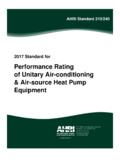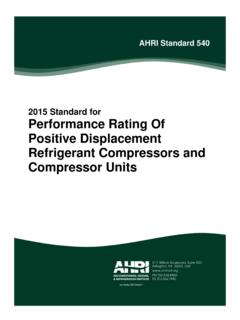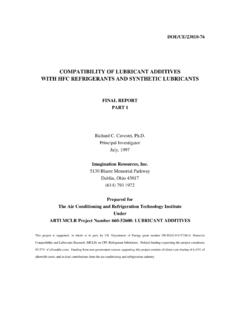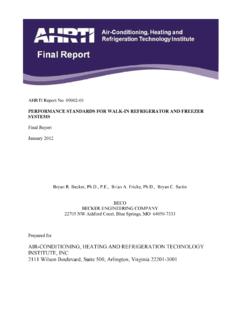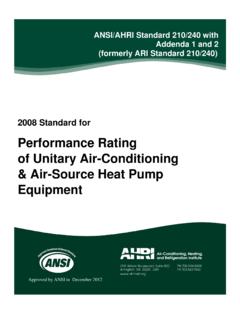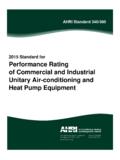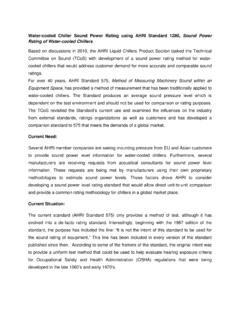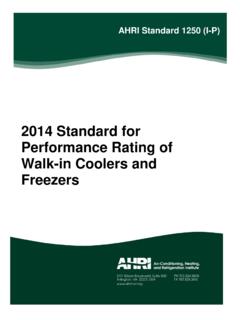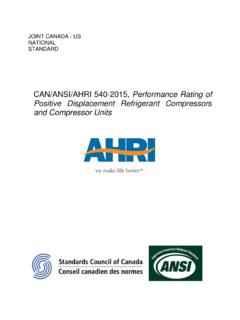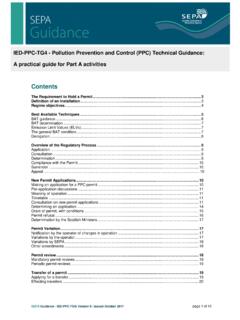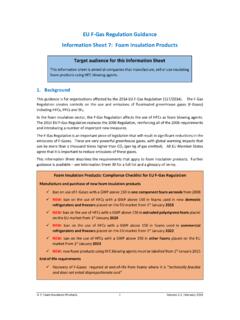Transcription of Everything You Need to Know About the Coming Changes …
1 Everything You Need to know About the Coming Changes in the Global, federal , and state refrigerant landscape Karim Amrane, VP, Regulatory & ResearchFrancis DietzVP, Public AffairsBig Changes Coming HFCs will be phased down Drivers: Montreal Protocol Amendment and Coming phase-down framework EPA SNAP Program / Climate Action Plan F-gas regulations in Europe California HFC proposals Canada HFC activities The good news: Our industry will bepreparedFor Discussion Today Where we are right now What is likely to occur, and when? Regulations Research Code Changes How will our industry respond? We have been preparing for this for a long time There is still a lot to doCFCsHCFCsHFCshigh chlorine strong ozone depletionstrong global warming 1974 Molina-Rowland theory 1987 Montreal Protocol 1990 CAA amendments 1996 total phaseoutof CFCslower chlorine lower ozone depletionlower global warming 2010 -phaseoutofHCFC-22 from new equipment 2020 -total phaseoutof HCFC-22no chlorine zero ozone depletionlower global warming 2014 F-Gas Europe 2015 EPA SNAP 2016 Montreal ProtocolHFC phasedown 2016 CARB 2016 ECCC Canada1930s-1990s1950s-2010s1990s +SO2 -NH31920stoxicflammableRefrigerant TransitionEuropean F-Gas Regulations.
2 Phase-down stepsYearReductionby2015100% (Freeze)2016-1793%2018-2063%2021-2345%20 24-2631%2027-2924%203021%93%63%45%31%24% 21%0%10%20%30%40%50%60%70%80%90%100%2015 201620182021202420272030F-Gas Regulations -GWP limits 2020/2022 GWP 2500 and150 Hermeticallysealedsystems(Refrigerators andFreezers) 2020 GWP 2500 Stationaryrefrigerationequipment 2022 GWP 150 and1500 Large commercialrefrigerationsystems 2020 GWP 150 Movablerooma/c appliances 2025 GWP 750 Small splita/c systems11. Refrigerators and freezers [..] for commercial use (hermetically sealed systems)that contain HFCs with GWP of 2500 or more1 January2020that contain HFCs with GWP of 150 or more1 January 2022 11a. Stationary refrigeration equipment, that contains, or that relies upon for its functioning HFCs with GWP of2500 or more except equipment intended for application designed to cool products to temperatures below -50 C1 January 202011b.
3 Multipack centralisedrefrigeration systems for commercial use with a capacity of 40kW or more that contain, or that rely upon for their functioning, fluorinated greenhouse gases with GWP of 150 or more, except in the primary refrigerant circuit of cascade systems where fluorinated greenhouse gases with a GWP of less than 1500 may be used1 January room air-conditioning appliances (hermetically sealed equipment which is movable between rooms by the end user) that contain HFCs with GWP of 150 or more1 January 202012a. Single split air-conditioning systems containing less than 3kg of fluorinated greenhouse gases, that contain, or that rely upon for their functioning, fluorinated greenhouse gases with GWP of 750 or more 1 January2025 North American HFC Phase Down Proposal Montreal ProtocolClimate Change Developments HFC phasedown agreement likely in 2016 37th OEWG, Geneva, Switzerland, 4 -8 Apr 2016 High Ambient Temperature (HAT) exemption List of countries List of products Multi-split air conditioners for commercial and residential Split ducted air conditioners (residential and commercial) Ducted commercial packaged (self-contained)
4 Air-conditioners 38th OEWG, Vienna, Austria, 18 -21 July 2016 Third Extraordinary Meeting of the Parties to the Montreal Protocol, Vienna, Austria, 22 -23 July 2016 28th Meeting of the Parties to the Montreal Protocol, Kigali, Rwanda, 10 -14 Oct Regulatory Activities on HFCs EPA SNAP President Obama s Climate Action Plan EPA to use SNAP program to encourage use of climate friendly alternatives Two rulemakings finalized in 2015 First rule added new low GWP refrigerants (subject to use conditions because of flammability) R-32 not approved in residential central AC, mini-splits and multi-splitsEPA SNAP 2015 Final Rule Commercial RefrigerationPhase-Out Candidates and Dates Refer to Tables 4, 5 and 6 of Final Rule for complete details Source: RajanRajendranEmersonPhase-OutRefrigeran tSuper-marketNewSuper-marketRetrofitRemo te <2,200 not contain flooded 2,200 or without flooded evap.
5 NewLTNewLT and MTRetrofitR-404A/507 AJan 1,2017 July 20,2016 Jan 1,2018 July 20,2016 Jan 1, 2019 Jan 1, 2020 Jan 1, 2020 July 20,2016R-410 AOK-OK-Jan 1, 2019 Jan 1, 2020 Jan 1, 2020-R-407A/C/FOKOKOKOKJan 1, 2019 Jan 1, 2020 Jan 1, 2020 OKHFC-134aOKOKOKOKJan 1, 2019 Jan 1, 2020 OKOKR eference: federal Register / Vol. 80, No. 138 / Monday, July 20, 2015 / Rules and Regulations, 42870-42959 EPA SNAP Proposed Rule April 2016 Phase out RefrigerantChillers (new)Cold Storage Warehouse (new)Retail Food Refrigeration Food Processing & Dispensing (new)R-134aJan 1, 2024 OKOKR-404 AJan 1, 2024 Jan 1, 2023 Jan 1, 2021R-407 A&B-Jan 1, 2023 Jan 1, 2021R-407 CJan 1, 2024-Jan 1, 2021R-410 AJan 1, 2024 Jan 1, 2023 Jan 1, 2021R-507 AJan 1, 2024 Jan 1, 2023 Jan 1, 2021US EPA: Additional Change of Status EPA: Additional Change of Status Environment & Climate Change Canada (ECCC) Proposal Mar 23, 2016 ECCC issued a consultation document on proposed regulatory measures on HFCs Objective harmonize with the SNAP Phase-down (North American Proposal) option also proposed (2019-90%; 2024-65%; 2030-30%; 2036-15%; baseline 2011-2013) Comment period ended April 29, 2016.
6 Final rule expected later this year or early in 2017* Limit and EffectiveDateRef Stand alone MTMax 650 GWP; Jan 1, 2020 Ref Stand alone LTMax 1500 GWP; Jan 1, 2020 Ref Central systems (racks, both MT/LT)Max 1500 GWP; Jan 1, 2020 FoamsMax150 GWP; Jan 1,2021AC ChillersMax 700 GWP; Jan 1, 2025 California Short-Lived Climate Reduction Strategy Proposed strategy issued on April 11, 2016 Reduce HFC emissions by 40% by 2030 Strategy includes: Incentive programs to defray cost of low-GWP California HFC phasedown if Montreal Protocol not successful in 2016 Ban on sale of high GWP refrigerants 2,500 and Next steps Public hearing April 26, 2016 Board hearing May 19, 2016 Comments due on May 26, 2016 Stationary Refrigeration orStationary Air-Conditioning SectorRefrigerants Prohibited in New Equipment with a 100-year GWP Value:Proposed Start DateNon-residential refrigeration150 or greaterJanuary 1, 2020 Air-conditioning (non-residential and residential)750 or greaterJanuary 1, 2021 Low-GWP AREP Cooperative research & testing program to identify suitable alternatives to high GWP refrigerants Evaluation of candidates strongly desired by OEMs The program is NOT to prioritize refrigerants, rather test and present objective results in a consistent manner Phase I was completed at the end of 2013.
7 38 refrigerants were evaluated in Phase I AHRI published 40 test reports Phase II started in 2014, testing concluded in 17 new refrigerants, high ambient testing 34 additional reports were published Final reports available to the public of Low GWP Candidates in Phase IBaselineRefrigerantComposition(Mass%)Cl assification (Note 1)GWP100 (Note 2)R22 ARM-32aR-32/R-125/R-134a/R-1234yf(25/30/ 25/20)A11577 LTR4XR-32/R-125/R-134a/R-1234ze(E)(28/25 /16/31)A11295N20R-32/R-125/R-134a/R-1234 yf/R-1234ze(E)( )A1975D52YR-32/R-125/R-1234yf(15/25/60)A 2L979L20R-32/R-152a/R-1234ze(E)(45/20/35 )A2L331 LTR6AR-32/R-744/R-1234ze(E)(30/7/63)A2L2 06R290R290100A311R1270R1270100A311R-134a AC5XR-32/R-134a/R-1234ze(E)(7/40/53)A162 2 ARM-41aR-32/R-134a/R-1234yf(6/63/31)A194 3D-4YR-134a/R-1234yf(40/60)A1574N13aR-13 4a/R-1234yf/R-1234ze(E)(42/18/40)A1604N1 3bR-134a/R-1234ze(E)(42/58)A1604XP-10R-1 34a/R-1234yf(44/56)A1631AC5R-32/R-152a/R -1234ze(E)(12/5/83)A2L92 ARM-42aR-134a/R-152a/R-1234yf(7/11/82)A2 L117R1234yfR1234yf100A2L4R1234zeR1234ze1 00A2L6R600aR600a100A311R290/R600aR290/R6 00a(40/60)A311 List of Low GWP Candidates in Phase IBaselineRefrigerantComposition(Mass%)Cl assification (Note 1)GWP100 (Note 2)R404 AARM-32aR-32/R-125/R-134a/R-1234yf(25/30 /25/20)A11577DR-33R-32/R-125/R-134a/R-12 34yf(24/25/26/25)A11410N40aR-32/R-125/R- 134a/R-1234yf/R-1234ze(E) (25/25/21/9/20)A11346N40bR-32/R-125/R-13 4a/R-1234yf (25/25/20/30)A11331 ARM-30aR-32/R-1234yf(29/71)A2L199 ARM-31aR-32/R-134a/R-1234yf(28/21/51)A2L 491D2Y65R-32/R-1234yf(35/65)A2L239DR-7R- 32/R-1234yf(36/64)A2L246L40R-32/R-152a/R -1234yf/R-1234ze(E)(40/10/20/30)A2L285R- 32R-32100A2L675R-32/R-134aR-32/R-134a(50 /50)A2L1053R290R-290100A311R410 AARM-70aR-32/R-134a/R-1234yf(50/10/40)A2 L482D2Y60R-32/R-1234yf(40/60)A2L272DR-5R -32/R-1234yf( )
8 A2L490 HPR1DR-32/R-744/R-1234ze(E)(60/6/34)A2L4 07L41aR-32/R-1234yf/R-1234ze(E) (73/15/12)A2L494L41bR-32/R-1234ze(E) (73/27)A2L494R32R32100A2L675R-32/R-134aR -32/R-134a(95/5)A2L713R-32/R-152aR-32/R- 152a(95/5)A2L647 Notes: Refrigerants classifications or intended classifications according to the ASHRAE Standard 34 (ASHRAE, 2010). Estimated GWP values from chemical producersList of Low GWP Candidates in Phase IIBaselineRefrigerantComposition(Mass%)C lassification (Note 1)GWP100 (Note 2)R22/R-407 CDR-93R-32/R-125/R-1234yf/R-134a20/20/31 /29A11251N-20bR-32/R-125/R-134a/R-1234yf 13/13/31/43A1988R-449BR-32/R-125/R-1234 (R-444B)R-32/R-1234 (R-452A)R-32/R-125/R-1234yf 11/59/30A12140N-40c (R-448A)R-32/R-125/R-134a/R-1234yf/R-123 4ze 26/26/21/20/7A11387 ARM-20aR-32/R-1234yf/R-152a18/70/12A2L13 9 HDR110R-32/R-1234yf/CO2 (E) 68/26/6A2L460DR-5A (R-454B)R-32 (E) 76/6/18A2L600L-41-1 (R-446A)R-32/R-1234ze/Butane 68/29/3A2L461L-41-2 (R-447A)R-32/R-1234ze/R-12568 : Refrigerants classifications or intended classifications according to the ASHRAE Standard 34 (ASHRAE, 2013).
9 GWP values are calculated based on IPCC AR-4 100 AREP Viable low GWP alternatives exist Many promising refrigerants are classified 2L under ASHRAE 34 (mildly flammable) ASHRAE 15 does not currently differentiate between 2 and 2L refrigerants IEC 60335-2-40 does not currently have requirements for 2L refrigerantsRisks of Flammable RefrigerantsMaximum Burning Velocity(m/s) of Combustion(kJ/kg)19000 Lower Flammability Limit(kg/m ) 3 Class 2 Subclass 2 LIncreasing severity of a combustion eventIncreasing probability of a combustion eventSlide Source: P. Johnson, ASHRAE 2012 Annual Meeting Seminar 11 What are 2L Refrigerants:-Exhibit flame propagation when tested at 60 C-LFL > kg/m -HOC < 19000 kJ/kg-SU m/sClass 2 & 3 Restrictions In general, it is very restrictive A2 or A2L refrigerants allowed in self-contained systems with less than 3kg (residential) or 10kg (commercial), depending on location in the building The current Standard 15 does not differentiate class 2 and 2L refrigerants because 2L is the sub-class of class 2 A3 cannot be used except if allowed by AHJ Exceptions: Laboratories with more than 100 ft2( m2) area per person Industrial occupancies Portable unit systems containing less than lb(150 g) of refrigerant chargeASHRAE Standard 15 Recent Activities 2L Working Group (WG) was tasked to propose requirements on equipment using 2L refrigerants.
10 The WG recent activities include: use of A2L refrigerants for human comfort with certain restrictions requirements for refrigerant leak detectors (definition, reliability, response time, etc.) ventilation requirements for the use of A2L refrigerants in machine room (current focus) and occupied space (later stage). Subcommittee was created to address residential Standard Subcommittee Proposed equipment coverage: split system AC&HPs and single package AC&HPs whole house dehumidifiers, whole house dehumidifiers/ventilators, and permanently connected heat pump water heaters Proposed scope: one-and two-family dwellings multi-family structures with individual dwelling units, where each dwelling unit has its own dedicated heating and air-conditioning system detached outbuildings (and garages , guest houses, pool houses, etc.) located on the same private property defined aboveASHRAE SSPC-15 Update ASHRAE , Safety Standard for Air conditioning and Heat Pump Systems in Residential Applications Target an Advisory Publication Review (APR) by the end of 2016 Plan Two Publication Public Reviews (PPR) in 2017 Standard to be approved by the end of 2017 ASHRAE 15: Issued an APR related to A2L refrigerants.
